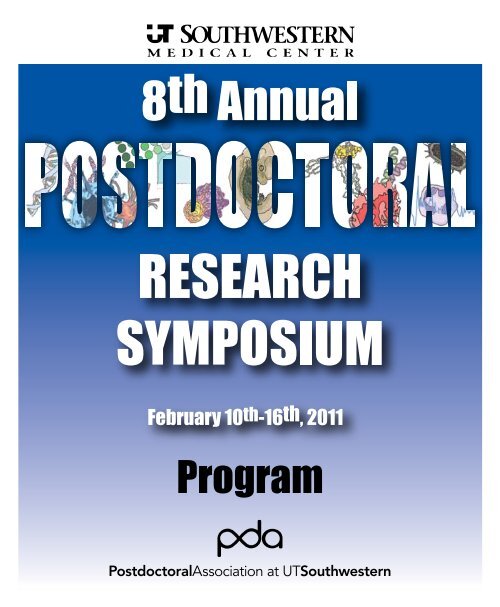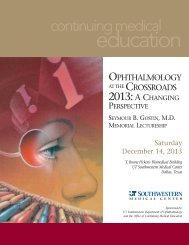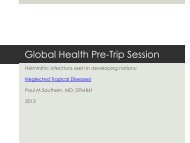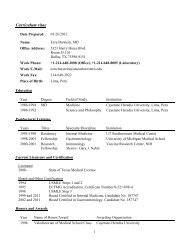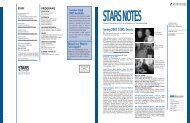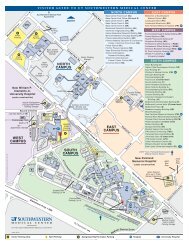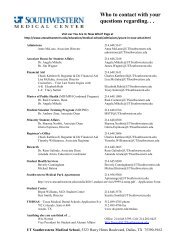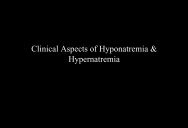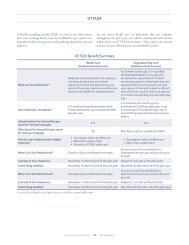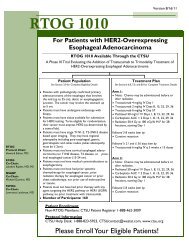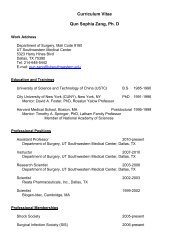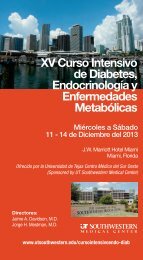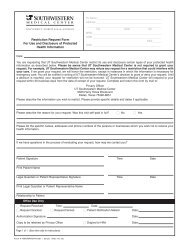UT Southwestern
UT Southwestern
UT Southwestern
You also want an ePaper? Increase the reach of your titles
YUMPU automatically turns print PDFs into web optimized ePapers that Google loves.
Schedule of Events<br />
Thursday, February 10th, 2011<br />
7:00pm Happy Hour Off Campus<br />
Sponsored by Postdoctoral Association Social Committee<br />
Friday, February 11th, 2011<br />
2:00-3:00pm Transferable Skills Workshop (By RSVP only) NB11.120<br />
Sponsored by the PDA Career Development Committee<br />
5:00pm Posters on display 3rd Floor Commons (NG3)<br />
Postdoctoral scholars display their posters.<br />
Monday, February 14th, 2011<br />
2:00-3:00pm CV/Resume Workshop (All welcome) EEF Auditorium (NB2)<br />
Sponsored by the PDA Career Development Committee<br />
Wednesday, February 16th, 2011<br />
1:30-3:30pm Poster Session 3rd Floor Commons (NG3)<br />
Postdoctoral scholars will be present at their posters to discuss their research. Refreshments will<br />
be served.<br />
4:00-5:00pm University Lecture Series EEF Auditorium (NB2)<br />
Speaker: Ruslan Medzhitov, Ph.D. Yale University School of Medicine, New Haven, CT<br />
Sponsored by the Postdoctoral Association at <strong>UT</strong> <strong>Southwestern</strong><br />
5:15-7:00pm Reception and Awards Ceremony 14th floor (ND14)<br />
Join us immediately following the ULS for a reception and presentation of awards, including:<br />
- Award for Excellence in Postdoctoral Research ($2000)<br />
- Best posters<br />
- Award for Excellence in Postdoctoral Mentoring<br />
- Distinguished Service Award<br />
Food & cash bar provided (one complimentary drink ticket for participants & judges).<br />
2010 Postdoctoral Research Symposium Poster Session
UNIVERSITY LECTURE<br />
Host Defense: Mechanisms and Pathways<br />
Ruslan Medzhitov, Ph.D.<br />
Professor, Howards Hughes Investigator, National Academy of Sciences<br />
Yale University School of Medicine, New Haven, CT<br />
Professor Medzhitov is the David W. Wallace Professor of Immunobiology at Yale and a Howard Hughes<br />
Medical Institute investigator. Dr. Medzhitov is a pioneering researcher in the field of the innate immune<br />
system and along with Dr. Charles Janeway made the groundbreaking discovery that Toll-like receptors,<br />
a component of the innate system, provide the adaptive system with the necessary information to create<br />
custom-made B and T cells that target specific bacterial or viral invaders. Dr. Medzhitov’s lab is continuing<br />
to investigate the role of Toll-like receptors in how the innate immune system controls the adaptive system<br />
– particularly their role in autoimmune disorders, inflammation and allergy – with the goal of developing<br />
new strategies for vaccine design. In recognition of his prolific contributions to the field of immunological<br />
research, in 2010 Dr. Medzhitov was elected to the National Academy of Sciences and was awarded the<br />
prestigious Lewis S. Rosenstiel Award for Distinguished Work in Basic Medical Science.<br />
Previous University Lecture speakers sponsored by the Postdoctoral Symposium:<br />
2010 Huda Zoghbi, M.D. Baylor College of Medicine<br />
2008 Tom Maniatis, Ph.D. Harvard University<br />
2007 Joan Massagué, Ph.D. Memorial Sloan-Kettering Cancer Center<br />
2006 Kathryn Anderson, Ph.D. Memorial Sloan-Kettering Cancer Center<br />
2005 Rama Ranganathan, M.D., Ph.D. <strong>UT</strong> <strong>Southwestern</strong> Medical Center<br />
2004 Suzanne Pfeffer, Ph.D. Stanford University
Acknowledgments<br />
The Postdoctoral Association at <strong>UT</strong> <strong>Southwestern</strong> medical center is proud to host the 8th Annual Postdoctoral<br />
Research Symposium. This symposium provides a platform for postdoctoral scholars from across the<br />
campus to present their research, and is a showcase for the outstanding work done at <strong>UT</strong> <strong>Southwestern</strong>.<br />
Over a hundred postdoctoral fellows will be presenting their work in this year’s symposium.<br />
An event of this scale is possible only due to the efforts of numerous people. The PDA received generous<br />
funding and administrative support from the former Dean, Dr. Melanie Cobb, as well as the Graduate<br />
School of Biomedical Sciences, who made this symposium possible. Our special thanks go out to Dr. Deirdre<br />
Brekken, Adjunct Assistant Professor and Michelle Greer, Administrative Associate in the Postdoctoral<br />
Affairs Office for their tireless efforts in organizing and coordinating this event. We also thank Dr. Susanne<br />
Mumby, Assistant Dean of Postdoctoral Affairs for her continued support.<br />
We would like to thank Dr. Steven McKnight, Professor and Chair of the Department of Biochemistry,<br />
who kindly agreed to be the symposium faculty chair this year. Dr. McKnight played an important role<br />
in the symposium, encouraging faculty involvement, coordinating poster judging and hosting the awards<br />
reception. We especially thank the faculty who participated in the symposium and served as judges for the<br />
posters submitted. Their support was critical towards the success of this event.<br />
As always we are grateful for the support from all our sponsors, listed in this symposium booklet, for<br />
providing funding to help make the Awards Reception a very special event.<br />
This event is unique in that it is organized and executed largely by the postdoctoral fellows themselves.<br />
This year was also special in that we have extended the symposium to include a postdoc mixer organized by<br />
the PDA Social Committee, as well as a workshop on transferable skills and CV/Resume seminar organized<br />
by the PDA Career Develeopment Committee. These efforts significantly increase the scope and breadth<br />
of the PDA symposium, and also speak of the strong collaborative efforts within the PDA community. A<br />
big thank you to these PDA committees. We hope to see more such participation next year. Finally, we<br />
would like to acknowledge our vibrant and ever-enthusiastic symposium committee members who took<br />
out time from their hectic schedules to help with the tremendous planning involved in making this event a<br />
successful one. We really appreciate all the time you put into this event.<br />
Finally, and most importantly, thank you to all the postdoctoral scholars at <strong>UT</strong>SW for their continuing<br />
commitment and dedication to science and discovery.<br />
Sincerely,<br />
Pavan Battiprolu, Ph.D. and Sunil Laxman, Ph.D.<br />
Co-Chairs, Eighth Annual Postdoctoral Research Symposium
The Annual Postdoctoral Research Symposium has become a keystone event that provides a wonderful<br />
platform for our postdoctoral community to showcase their scientific research and promotes the free<br />
exchange of scientific ideas of things yet to come. It also serves the stated mission of the Postdoctoral<br />
Association, “to develop a sense of community throughout our institution”. The Postdoctoral Association<br />
grows increasingly proud of the research accomplished by postdoctoral scholars here at <strong>UT</strong> <strong>Southwestern</strong>.<br />
Our postdoctoral community continues making milestone contributions to a wide variety of science fields.<br />
On behalf of the Postdoctoral Association I would like to thank all of the participants who have graciously<br />
agreed to share their work with the university as a whole. I would also like to thank the organizers who<br />
have volunteered their time and efforts to making the annual Postdoctoral Research Symposium a successful<br />
event.<br />
Thank you and congratulations,<br />
Jose A. Barrera, Ph.D.<br />
President, Postdoctoral Association<br />
2010 Symposium Committee<br />
Back row: Jill Larsen, Elhadji Dioum, Sunil Laxman, Steve McKnight, Wen-Huang (Lisa) Ko, Jyh-Yeuan<br />
(Eric) Lee, Pavan Battiprolu, Houda Benlhabib. Front row: Daniela Derderian, Brett Pickett, Charlene<br />
Supnet, Diana Canseco, Myriam Iglewski, Deirdre Brekken. Not pictured: Michelle Greer, Sohini<br />
Mukherjee.
AWARDS<br />
Distinguished Service Award<br />
This award honors a <strong>UT</strong> <strong>Southwestern</strong> postdoctoral fellow, faculty, or staff member who has shown<br />
extraordinary dedication to helping <strong>UT</strong> <strong>Southwestern</strong> postdoctoral scholars. The Postdoctoral Association<br />
(PDA) is proud to announce that the recipients for this year’s award are Cathy Cavins and Cory Blaiss,<br />
Ph.D.<br />
Cathy Cavins joined the Graduate School staff in November 2004. With<br />
Cathy’s assistance, both the Postdoctoral Affairs Office and the PDA at <strong>UT</strong><br />
<strong>Southwestern</strong> were established. Cathy was a dedicated advocate for the<br />
postdoctoral scholars by providing them guidance in both their training<br />
and along their career path. Her support of postdoctoral training greatly<br />
enhanced the experience of postdoctoral scholars at <strong>UT</strong> <strong>Southwestern</strong>.<br />
Since June 2009, Cathy has been serving the Postdoctoral Affairs Office<br />
as a Subject Matter Expert for the Campus Solutions PeopleSoft project,<br />
which will replace the current postdoctoral certificate registration system<br />
next year.<br />
Dr. Cory Blaiss joined the lab of Dr. Craig Powell in the Department of<br />
Cathy Cavins<br />
Neurology as a postdoctoral scholar in 2008. Shortly after coming to <strong>UT</strong><br />
<strong>Southwestern</strong>, Cory enthusiastically volunteered for many PDA committees. Her most prominent and<br />
passionate involvements include, President (2008-2009), Co-chair of the Career Development Committee<br />
(2008-2010), Treasurer (2009-2010), and postdoctoral departmental representative for the Department of<br />
Neurology. Cory also demonstrated untiring dedication and enthusiasm as a member of the Symposium,<br />
Standards, and Outreach committees. Her initiative was evident in the ideas she implemented after<br />
attending the annual National Postdoc Association (NPA) meeting in<br />
2009 as well as her pioneering contributions towards workshops on<br />
negotiations skills, peer-mentoring discussions and updating the PDA<br />
travel awards. In addition to the PDA committees, Cory served on the<br />
Student/Trainee Subcommittee of the <strong>UT</strong> <strong>Southwestern</strong> Six-Year Planning<br />
Committee (2009-2010). Cory continues to be an active member of the<br />
Advocacy Committee of the NPA. It is her remarkable leadership qualities<br />
that serve as a role model for other postdoctoral scholars.<br />
Together with faculty members, both Cathy and Cory have served on the<br />
Postdoctoral Advisory Committee. We take this opportunity to thank<br />
Cathy and Cory for their dedicated and selfless efforts to advocate for<br />
all postdoctoral scholars and for their help in bringing the PDA and<br />
Postdoctoral Symposium to where they stand today.<br />
Cory Blaiss, Ph.D.<br />
Previous winners of the Distinguished Service Award:<br />
2010 Brenda Timmons, Ph.D. Postdoctoral Fellow, Dept. of Ob/Gyn (2003-2009)<br />
2008 Sue Harjo Director of Graduate and Postdoctoral Affairs (2003-2008)
AWARDS<br />
Award for Excellence in Postdoctoral Mentoring<br />
This award recognizes and honors <strong>UT</strong> <strong>Southwestern</strong> faculty who have demonstrated excellence in their<br />
ability to advise and mentor postdoctoral scholars. The finalists for this award consistently demonstrate a<br />
strong commitment to postdoctoral mentoring by providing research guidance in a healthy and collaborative<br />
working environment. They are committed to promoting career development, whether it be fostering the<br />
transition to independence or supporting the scholar in an alternative career path.<br />
Over thirty different faculty members were nominated for the award by their current postdoctoral scholars,<br />
and we thank all the postdocs who wrote such wonderful nomination letters in support of their mentors. The<br />
finalists have been notified and the two winners of the 2011 Award will be announced at the Symposium’s<br />
Reception and Awards Ceremony. We hope that everyone will be able to attend and express their support<br />
for continuing excellence in postdoctoral mentoring at <strong>UT</strong> <strong>Southwestern</strong>.<br />
Previous winners of the Award for Excellence in Postdoctoral Mentoring:<br />
2010 David Corey, Ph.D. Dept. of Pharmacology<br />
Gang Yu, Ph.D.<br />
Dept. of Neuroscience<br />
2008 Harold “Skip” R. Garner, Jr., Ph.D. Dept. of Biochemistry
AWARDS<br />
Award for Excellence in Postdoctoral Research<br />
This top award honors the outstanding accomplishments of a postdoctoral scholar participating in the<br />
Postdoctoral Certificate Training Programs of the Graduate School of Biomedical Sciences. Nominations are<br />
sought from faculty members and postdoctoral scholars and finalists are interviewed by the Committee on<br />
Graduate School Awards. The committee chooses the awardee based on the scholar’s creativity, productivity<br />
during postdoctoral training, presentation skills and potential of an outstanding independent research<br />
path and on his or her research project’s originality, depth, and documented scientific impact. The award<br />
includes $2000 and presentation of the University Lecture the week following the Awards Reception.<br />
Susanne Mumby, Ph.D.<br />
Assistant Dean of Postdoctoral Affairs<br />
2011 Finalists for Excellence in Postdoctoral Research<br />
William Holland, Ph.D.<br />
Dept. of Internal Medicine<br />
Mentor: Philipp Scherer, Ph.D.<br />
Viviana Moresi, Ph.D.<br />
Dept. of Molecular Biology<br />
Mentor: Eric Olson, Ph.D.<br />
Carrie Partch, Ph.D.<br />
Dept. of Biochemistry<br />
Mentor: Kevin Gardner, Ph.D.<br />
Tongjin Zhao, Ph.D.<br />
Dept. of Molecular Genetics<br />
Mentor: Joseph Goldstein, M.D.<br />
Previous winners of the Award for Excellence in Postdoctoral Research:<br />
2010 Lit-Hsin Loo, Ph.D. Dept. of Pharmacology Mentor: Lani Wu, Ph.D. &<br />
Steven Altschuler, Ph.D.<br />
2008 Shusheng Wang, Ph.D. Dept. of Molecular Biology Mentor: Eric Olson, Ph.D.<br />
2007 Angelique Whitehurst, Ph.D. Dept. of Cell Biology Mentor: Michael White, Ph.D.
INDEX OF POSTERS<br />
BY CATEGORY<br />
Biochemistry<br />
1. Schaeffer R, Automated domain partition using evolutionary considerations<br />
2. Lee A, WNK3 is a component of RNA granules<br />
3. Yu S, Capturing O-GlcNAc’s interactions via photocrosslinkable sugar<br />
4. Hattne J, Independent component analysis of noisy data<br />
5. Stiffler M, The heterogeneity of mutational tolerance in a protein is dependent on the strength of<br />
selective pressure<br />
6. Sankella S, Determination of the sn-2 fatty acid composition of liver phospholipids in Agpat2 knockout<br />
mice<br />
7. Han Y, The facilitation of gamma-secretase proteolytic activity by the extracellular domain of Nicastrin<br />
is dependent on a major conformation change<br />
8. Kumar B, Rpt3, an ATPase subunit of PA700 (19S regulator), is essential for asymmetric assembly of<br />
26S proteasome<br />
9. Huang Y, Nutritional regulation of PNPLA3 in liver<br />
10. Li B, A two-hybrid assay to study protein interactions within the secretory pathway<br />
11. Correa F, Blue light sensing two-component systems: structural studies in a anti-antisigma factor<br />
response regulator<br />
12. Sun T, The PR70 subunit of PP2A regulates the levels of Cdc6 and DNA pre-replication complex<br />
formation in U2OS cells<br />
13. Jia D, Mechanism of retromer-coated endosomal tubulation and tubular scission<br />
14. Reynolds K, A mechanism for the evolution of allosteric control in proteins<br />
15. Annavarapu H, Hypoxia mediates cervical ripening by repressing MITF gene expression and<br />
activation of IL8 gene expression<br />
16. Kim J, Vacuum matrix sublimation for self-assembled monolayer desorption/ionization immunoassay<br />
17. Ramesh A, RNA-mediated gene regulation by bacterial two-component systems<br />
18. Dorwart M, MscL is a pentamer in vivo but of variable stoichiometries in vitro: implications for<br />
detergent-solubilized membrane proteins<br />
19. He X, A multi-layered autoinhibition mechanism of FARP2, a GEF involved in plexin signaling<br />
Cancer Biology<br />
20. Marin-Valencia I, Does the Warburg effect exist in vivo Analyzing glucose metabolism in FDG-PETpositive<br />
tumors using 13C-NMR spectroscopy<br />
21. Yaacoub R, Expression of cell cycle-related Molecular Markers in patients treated with radical<br />
cystectomy for sqamous cell carcinoma of the bladder<br />
22. Li L, Modulating endogenous NQO1 levels identifies key regulatory mechanisms of action of ß-<br />
lapachone for pancreatic cancer therapy<br />
23. Park J, PRMT1-mediated methylation of high-risk HPV-16 E6 oncoprotein derepresses p53-dependent<br />
gene transcription<br />
24. Tiwari A, Expression of SOX9 differs in esophageal squamous cells from GERD patients with and<br />
without Barrett’s esophagus<br />
25. Fattah K, Role of DNA-PK in homologous recombination<br />
26. Larsen J, Defining the role of ZEB1 in the molecular pathogenesis of lung cancer<br />
27. Alcantara Llaguno S, Hox genes are essential for glioma stem cell survival and tumorigenicity<br />
28. Potts M, Identification of genetic and chemical inhibitors of multiple cancer-related signaling<br />
pathways
Cancer Biology, continued<br />
29. Park J, Adipocyte-derived Type VI Collagen A3-C5 promotes mammary tumor growth and metastasis<br />
in vivo<br />
30. Rabellino A, The SUMO ligase PIAS1 promotes tumorigenesis through regulation of PML protein<br />
levels<br />
31. Schuster K, Lung cancer initiating cells in a mouse model deficient in Cdkn2ab<br />
32. Cheng T, Pyruvate carboxylase catalyzes an alternative metabolic strategy allowing tumor cells to<br />
escape glutamine dependence<br />
33. Galindo K, D-Mef2 studies in a drosophila model of rhabdomyosarcoma<br />
34. Dellinger M, Inhibition of VEGF-A activation of VEGFR2 blocks lymphangiogenesis by preventing<br />
LEC proliferation and migration<br />
35. Sun J, Ku Blocking on Exo1-mediated end resection is not resolved by Mre11<br />
Cardiology<br />
36. Iglewski M, Developing an in vitro model for studying cardiomyocyte mitophagy<br />
37. Burchfield J, Induction of cardiac myocyte phenotype in adipose-derived stem cells by a novel<br />
cardiogenic small molecule<br />
38. Nemchenko A, AMPK suppresses autophagy in redox-stressed cardiomyocytes<br />
39. Rotter D, What are the relevant targets of circadian calcineurin/NFAT activity in the heart<br />
40. Battiprolu P, Persistent activation of FoxO transcription factors contributes to insulin resistance and<br />
diabetic cardiomyopathy<br />
41. Zhu M, The role of FoxO4 in the remodeling process after myocardial infarction<br />
42. Canseco D, Cytoglobin: a stress-responsive hemoprotein regulating cardiomyocyte homeostasis and<br />
survival<br />
43. Zhang Q, The histone trimethyl demethylase, JMJD2A, promotes pressure overload-induced cardiac<br />
hypertrophy<br />
44. Lee W, PDZK1 in vascular smooth muscle provides protection from neointima formation<br />
Cell Biology<br />
45. Saddar S, Scavenger receptor Class B Type I (SR-BI) is a plasma membrane cholesterol sensor<br />
46. Shah P, Abrogation by N-acetyl cysteine of cytotoxic and metabolic effects of silver cations on a model<br />
of respiratory epithelium<br />
47. Yarbrough M, miRNA regulation of viral infection and mRNA export pathways<br />
48. Lai H, Brd4 inhibits G9a-mediated methylation of Histone H3 and p53<br />
49. Morales J, Linking transcription termination and DNA damage response through KUB5 function<br />
50. Song K, Cardiac repair by reprogramming fibroblasts to cardiomyocytes by defined factors<br />
51. Herrera-Herrera M, Role of DDR2 in adhesion, contraction and migration of fibroblasts<br />
52. Han S, A human SPO7 candidate that forms a phosphatase complex with CTPNEP1 (formerly<br />
Dullard) to activate lipin<br />
53. Wu Q, Identification of point mutations of estrogen receptor a (ERa) that provide genetic segregation<br />
of nuclear versus non-nuclear receptor function<br />
54. Tomimatsu N, DNA resection by Exo1 dictates critical DNA repair and damage signaling decisions in<br />
response to DNA double-strand breaks<br />
55. Ning J, CrGex1 is a gamete-specific protein required for zygote germination<br />
Chemistry<br />
56. Hu Y, Biologically active natural products from marine microorganisms
Chemistry, continued<br />
57. Soheili A, Synthesis of unnatural amino acids from glycine<br />
Computational and Systems Biology<br />
58. Cheng H, Detecting remote protein homologs using structures and sequences<br />
59. Artyukhin A, Quorum sensing in C. elegans starvation<br />
60. Jilkine A, A density-dependent switch for controlling the onset of stochastic cell polarization and<br />
formation of signalling clusters<br />
61. Poelwijk F, The evolutionary design of proteins<br />
Developmental Biology<br />
62. Gao Z, REST/NRSF: Guardian of the neuronal genome in quiescent stem cells to controls adult<br />
neurogenesis<br />
63. Mogami H, Thrombin - a pathologic factor in preterm labor and preterm rupture of membranes<br />
64. Moon J, Systematic analysis of Wnt/Hh small molecule inhibitors in zebrafish<br />
65. Meadows S, Neuronal guidance cues direct dorsal aortae formation during vasculogenesis<br />
66. Deering T, Genome-wide ChIP-seq analysis of the components of the PTF1 complex in the mouse<br />
pancreas<br />
Imaging and Nanomedicine<br />
67. Zhou K, Selective “ON/OFF” activation of tunable and pH-responsive fluorescence nanoprobes in<br />
different endocytic organelles<br />
68. Huang X, “On-Off” pH-responsive 19F imaging nanoprobes for MRI<br />
69. Zhou Y, Evaluation of pH-sensitive linkers for the development of ß-lapachone prodrug Micelles<br />
70. Huang G, Multifunctional polymeric Micelles for MR imaging and targeted chemotherapy on lung<br />
cancer<br />
Immunology<br />
71. Zhou X, The two Ig gene enhancers, E3 and Ed, are essential for triggering transcription1<br />
72. Patel D, FcRn blockade by Fc engineering ameliorates arthritis in a murine model<br />
73. Qin Z, Antibody against nucleolin in organ transplant recipients<br />
74. Guidry P, An HLA allele frequency-based approach to resolving allelic and genotypic ambiguity in<br />
HLA typing data and its implementation in ImmPort<br />
Microbiology<br />
75. Krachler A, A new class of gram-negative adhesins mediates multivalent, high-affinity binding to<br />
mammalian cells<br />
76. Reddick L, Biophysical characterization of an E. coli secreted effector protein reveals a mechanism of<br />
virulence<br />
77. Parker C, The possible roles of conserved amino acids in the periplasmic domain of<br />
enterohemorrhagic Escherichia coli sensor kinase QseC<br />
Molecular Genetics<br />
78. Aurora A, Protection of the heart against stress-induced calcium overload by microRNA-214<br />
79. Li B, Stable suppression of Glis2/Nephrocystin-7 results in aberrant centrosome duplication and<br />
nuclear division in kidney tubular cells in vitro<br />
80. Zhao T, Ghrelin secretion and its role in survival of famine
Neuroscience<br />
81. Tseng B, Life-long aerobic training preserves white matter integrity: a first look in the masters athlete’s<br />
brain<br />
82. Masiulis Bowen I, How does morphine influence the maturation and dendritic arborization of adultgenerated<br />
dentate gyrus granule cells<br />
83. Xu Y, Self-modulating of Mint1 in its interaction with amyloid precursor protein<br />
84. Petrik D, Small-molecule upregulation of adult neurogenesis in vivo through Mef2-dependent<br />
mechanisms<br />
85. Smith L, Fragile-X mental retardation protein (FMRP) is required for cocaine-induced behavioral<br />
plasticity<br />
86. Taniguchi M, Histone deacetylase 5 limits cocaine reward through cAMP signaling<br />
87. Niu W, Nuclear receptor TLX controls adult neural stem cell activation and positioning<br />
88. Speed H, Impaired synaptic connectivity in the Neuroligin3 R451C mouse model of autism<br />
89. Sephton C, Identification of neuronal RNA targets of TDP-43-containing ribonucleoprotein complexes<br />
90. Torres-Altoro M, Neuroprotective strategies for traumatic brain injury<br />
91. Lai H, In vivo cell-type specific targets of Atoh1 (Math1) in dorsal spinal cord interneurons<br />
92. Jakkamsetti V, In vivo induction of ARC mRNA primes CA1 pyramidal cells for MGLUR dependent<br />
ltd<br />
93. Tsai N, Protocadherin-10 mediates MEF2- and FMRP-dependent synapse elimination<br />
94. Amiri A, Mouse model of human autism spectrum disorder: gene targeting in specific brain regions<br />
95. Cui H, Melanocortin-4 receptor signaling in the lateral hypothalamic area regulates acute responses to<br />
high fat diet<br />
96. Chan C, Functional profiling of Rab GTPases in the drosophila nervous system<br />
97. Kumar R, Loss of acetylation at H4k16 in purkinje cells results in Ataxia-Telangiectasia-Like<br />
neurological phenotype<br />
Pharmacology<br />
98. Potthoff M, Molecular and metabolic basis of bile acid sequestrant action on cholesterol and glucose<br />
metabolism<br />
99. Ellison T, Determining the functions and partners of insulin and LXR regulated proteins that control<br />
lipogenesis<br />
100. Owen B, The fasting hormone, FGF21, causes female infertility in mice<br />
101. Holmstrom S, LRH-1 cooperates with PTF1 to regulate exocrine pancreas function<br />
102. Wauson E, The G protein coupled taste receptor T1R1/T1R3 is a novel regulator of mTOR and<br />
autophagy<br />
103. Dioum E, Small molecule regulating pancreatic beta cell function<br />
104. Thomas J, Fully human anti-phosphatidylserine monoclonal antibodies capable of direct and indirect<br />
antiviral activity protects guinea pigs from hemorrhagic arenaviruses<br />
105. Ding X, Beta-Klotho in adipose tissue is required for the anti-obesity effect of Fibroblast Growth<br />
Factor 21 in mice<br />
Physiology<br />
106. Fujimoto N, Effect of aging on left ventricular compliance and distensibility in healthy sedentary<br />
humans<br />
107. Carrick-Ranson G, Left ventricular mass increases with life-long training volume irrespective of<br />
scaling unit<br />
108. Berglund E, Targeted reactivation of leptin receptors in POMC neurons improves glucose
Physiology, continued<br />
homeostasis and hepatic insulin action in the mouse<br />
109. Akgul Y, Changes in glycosaminoglycan (GAG) composition in the cervix during normal pregnancy<br />
and preterm labor<br />
110. Okada Y, Effects of sex on sympathetic neural and hemodynamic responses to head-up tilt in<br />
hypertensive seniors<br />
111. Chang A, Zipper-Interacting Protein Kinase phosphorylates myosin and is associated with<br />
maintenance of cardiac function<br />
112. Piper P, Studying physiologic signals for ghrelin secretion using a novel genetic mouse model of<br />
hyperghrelinemia<br />
113. Mari Y, HDAC inhibitors exert dramatic effects on cholesterol homeostasis in the central nervous<br />
system, but fail to affect the progression of Niemann-Pick type C disease<br />
114. Wernstedt Asterholm I, Fasting-induced changes in the acute-phase response in adipose tissue<br />
115. Kusminski C, MitoNEET: a major regulator of mitochondrial function and lipid homeostasis<br />
116. Jarvis S, Racial differences in neural and humoral control of blood pressure during early pregnancy<br />
117. Zhu Y, Impact of aging and life-long exercise on cerebrovascular CO2 reactivity<br />
Psychiatry<br />
118. Guzman D, Transient inactivation of NMDA receptors in the ventral tegmental area enhances the<br />
incentive motivational properties of cocaine<br />
119. Chuang J, Ghrelin mediates stress-induced food reward behaviors<br />
120. Shukla A, Molecular alterations associated with the COMT val158met polymorphism in<br />
schizophrenia<br />
121. Yanagi M, Immunoquantification of Kv3.2, GAD67 and GAD65 in prefrontal cortex of schizophrenia<br />
and antipsychotics-treated rats<br />
Radiological Sciences<br />
122. Lin C, Detection of paraCEST agents with reduced MT interference using Frequency Labeled<br />
Exchange Transfer (FLEX)<br />
123. Kim S, Bardoxolone methyl, a novel EGFR activator that protects human colonic epithelial cells<br />
against radiation<br />
124. Wang Y, Ultra-pH responsive micellar nanoprobes for cancer molecular imaging<br />
125. Chiguru S, Synthesis and evaluation of F-18 labeled hydroxyquinoline derivatives as PET imaging<br />
agents for early detection of Alzheimer’s plaques<br />
126. Hao G, Dual molecule presentation on a multifunctional scaffold for specific prostate cancer imaging<br />
127. Lumata L, Generating >60,000-fold room-temperature yttrium-89 NMR signal enhancement for<br />
magnetic resonance imaging<br />
Surgery<br />
128. Oni G, A histological comparison of fractional ablative laser treatment in human facial and<br />
abdominal skin - the effect of double pulsing<br />
129. Arain N, A randomized comparison of laparoscopic, magnetically anchored, and flexible endoscopic<br />
cameras on ex-vivo and in-vivo performance and workload for laparoscopic and single incision<br />
surgery
The Symposium Committee acknowledges<br />
the generous support of our corporate sponsors:<br />
Bio-Rad<br />
Clontech<br />
Corning<br />
Crystal Chem<br />
eBioscience<br />
Life Technologies<br />
Miltenyi Biotech<br />
New England Biolabs<br />
Qiagen<br />
Reata<br />
Teklad-Harlan<br />
VWR<br />
Zhang and Associates, P.C.
DISCOVER<br />
OUR DISTINCT<br />
Advantages<br />
•DIABETES<br />
•OBESITY<br />
Crystal Chem ELISA Kits extend your purchasing power<br />
and research efficiency. With our advanced technology<br />
you gain precision, recovery and reproducibility, even<br />
with a smaller sample volume.<br />
Crystal Chem ELISA Kits<br />
(Mouse/Rat Insulin Assay, Mouse/Rat Leptin Assay)<br />
Only 5µl sample size<br />
Higher sensitivity using 5µl sample<br />
Excellent precision, recovery and reproducibility<br />
Kits are designed to minimize inhibition effect<br />
Small sample volume and reliable results produce<br />
significant time & animal cost savings<br />
Ultra Sensitive Mouse & Rat Insulin ELISA Kits<br />
Low and High insulin assay using same kit<br />
Low insulin assay – 0.1 to 6.4ng/ml<br />
Wide insulin assay – 0.1 to 12.8ng/ml (screening purpose)<br />
High insulin range – 1.0 to 64ng/ml<br />
Kits come with specific mouse or rat insulin standard<br />
New & improved, easy to use version of Rat Insulin ELISA<br />
Kit (INSKR020) coming soon!<br />
90060 Ultra-Sensitive Rat Insulin ELISA Kit<br />
90080 Ultra-Sensitive Mouse Insulin ELISA Kit<br />
INSKR020 Rat Insulin ELISA Kit<br />
INSSM021 Mouse Insulin Standard 2ng (Use with INSKR020)<br />
90030 Mouse Leptin ELISA Kit<br />
90040 Rat Leptin ELISA Kit<br />
For research use only, not for<br />
use in diagnostic procedures.<br />
CRYSTAL CHEM INC.<br />
1536 Brook Drive, Suite A,<br />
Downers Grove, IL 60515, USA<br />
Tel: (630) 889-9003 • Fax: (630) 889-9021<br />
sales@crystalchem.com • www.crystalchem.com
Everyday needs. Everyday answers.<br />
From cell culture to real-time PCR—we have what you need<br />
AmpliTaq Gold ®<br />
PCR Master Mix<br />
ViiA 7 TM<br />
Real-Time PCR<br />
Gibco ®<br />
Cell Culture Media<br />
StepOne Plus TM<br />
Real-Time PCR<br />
NuPage Gels<br />
Veriti TM<br />
Thermal Cycler<br />
Quality Products Available at<br />
the Supply Center NB6.134<br />
Taqman TM<br />
Gene Expression<br />
Yolanda Bell<br />
Life Technologies Account Manager II<br />
Yolanda.Bell@lifetech.com<br />
Colleen Tanner<br />
SC Associate<br />
sc_ustw@yahoo.com<br />
Debra DiGiacomo<br />
Applied Biosystems Instrument Account Manager<br />
Debra.Digiacomo@lifetech.com<br />
Kelli Dietel<br />
Applied Biosystems Genetic Systems<br />
Kelli.Dietel@lifetech.com
Bio-Rad Laboratories has a 50-year history<br />
of developing and providing technologies<br />
to support scientific discovery.<br />
We support a range of scientific workflows<br />
for both proteins and nucleic acids and<br />
can provide the tools and expertise to support<br />
virtually any type of research:<br />
Gene expression and modulation<br />
Protein separation and analysis<br />
<br />
Protein purification<br />
<br />
Protein interaction analysis<br />
Biomarker discovery and characterization<br />
Coming in February<br />
Mini Trans-Blot ® Turbo <br />
Western blots in as few<br />
as 3 minutes<br />
Ask about Bio-Rad’s<br />
Real-time PCR detection<br />
systems.<br />
new!<br />
To learn more, contact your local Bio-Rad representative:<br />
Rachelle Alderson<br />
Account Manager<br />
1-972-809-4558<br />
rachelle_alderson@bio-rad.com<br />
Rick Cowan<br />
Instrument Systems Specialist<br />
1-405-850-4479<br />
rick_cowan@bio-rad.com<br />
Gel Doc EZ one button<br />
imaging and analysis
Automated solutions from sample to result:<br />
• The widest choice of sample processing protocols<br />
• Low-, medium-, and high-throughput automation<br />
• Leading solutions for molecular diagnostics<br />
• Plug-and-play automated sample preparation<br />
• Quantitative, real-time PCR detection<br />
• Automated analysis of DNA fragments and RNA<br />
• High-resolution sequence-based DNA detection and quantification<br />
Making improvements in life possible — www.qiagen.com<br />
For more information contact your local QIAGEN sales representative:<br />
Heather Gerich – heather.gerich@qiagen.com – 214-502-8246
Improve Your DNA Delivery Results<br />
Transfect<br />
with confidence<br />
Enhance<br />
your transduction<br />
www.clontech.com/xfect<br />
www.takara-bio.us<br />
For more information, contact<br />
Kayla Johnson<br />
kayla_johnson@clontech.com<br />
214.236.1267
eBioscience delivers MORE choice<br />
with a FULL SPECTRUM of cell analysis products<br />
FLOw CyTOMETRy<br />
Treg, Th17, Tfh & Cytokine Biology<br />
Dendritic Cell Antibodies<br />
Broadest range of fluorophores<br />
Flexible sizing options<br />
IMMUnOaSSay<br />
FlowCytomix Multiple Analyte Detection Systems<br />
Instant ELISA – Just add sample<br />
Platinum ELISA – High-performance<br />
Ready-SET-Go® ELISA – Flexible alternative<br />
FUnCTIOnaL aSSay<br />
High-Quality Recombinant Proteins<br />
Functional Grade Antibodies<br />
wESTERn bLOTTIng<br />
TrueBlot® Reagents – Eliminates heavy or light<br />
chain Ig bands for publication-quality data<br />
Cell Biology & Signaling Antibodies<br />
MULTICOLOR IMagIng & MICROSCOPy<br />
eFluor® Nanocrystal Conjugation Kits<br />
Directly Conjugated Antibodies<br />
QC validated for IHC/IF<br />
www.eBioscience.com<br />
ORDER TECH INQUIRIES info@eBioscience.com<br />
Q111006-More-<strong>UT</strong>SW.indd 1<br />
1/14/11 4:28 PM
UNDERSTANDING CHANGE<br />
New tools to advance epigenetics research<br />
For over 35 years, New England Biolabs has been committed to understanding the mechanisms of restriction and<br />
methylation of DNA. This expertise in enzymology has recently led to the development of a suite of validated<br />
products for epigenetics research. These unique solutions to study DNA methylation are designed to address some<br />
of the challenges of the current methods. EpiMark validated reagents simplify epigenetics research and expand<br />
the potential for biomarker discovery.<br />
EpiMark validated products include:<br />
Newly discovered methylation-dependent restriction enzymes<br />
A novel kit for 5-hmC and 5-mC analysis and quantitation<br />
Methyltransferases<br />
Histones<br />
Genomic DNAs<br />
To learn how these products can help you to better<br />
understand epigenetic changes, visit neb.com/epigenetics.<br />
CLONING & MAPPING<br />
DNA AMPLIFICATION<br />
& PCR<br />
RNA ANALYSIS<br />
PROTEIN EXPRESSION<br />
& ANALYSIS<br />
GENE EXPRESSION<br />
& CELLULAR ANALYSIS<br />
www.neb.com
Teklad Custom Research Diets<br />
40 Years experience, 20,000+ Formulas<br />
Harlan and the Harlan logo are trademarks and trade names of Harlan Laboratories, Inc.<br />
Common classes of custom diets include:<br />
• High fat (40-60% kcal from fat)<br />
• High carbohydrate (fructose, sucrose)<br />
• Atherogenic (cholesterol, fat, cholate)<br />
• Vitamin & mineral adjusted<br />
• <br />
• Doxycycline & tamoxifen containing diets<br />
• Addition of customer-supplied ingredients/compounds<br />
www.harlan.com<br />
Contact one of our staff nutritionists at:<br />
askanutritionist@harlan.com<br />
Corporate Headquaters<br />
Harlan Laboratories, Inc.<br />
8520 Allison Pointe Blvd., Suite 400<br />
Indianapolis, IN 46250<br />
800 793-7287
A<br />
Akgul, Yucel 109<br />
Alcantara Llaguno, Sheila 27<br />
Amiri, Anahita 94<br />
Annavarapu, Hari Kishore 15<br />
Arain, Nabeel 129<br />
Artyukhin, Alex 59<br />
Aurora, Arin 78<br />
B<br />
Battiprolu, Pavan 40<br />
Berglund, Eric 108<br />
Burchfield, Jana 37<br />
C<br />
Canseco, Diana 42<br />
Carrick-Ranson, Graeme 107<br />
Chan, Chih-Chiang 96<br />
Chang, Audrey 111<br />
Cheng, Hua 58<br />
Cheng, Tzuling 32<br />
Chiguru, Srinivas 125<br />
Chuang, Jen-Chieh 119<br />
Correa, Fernando 11<br />
Cui, Huxing 95<br />
D<br />
Deering, Tye 66<br />
Dellinger, Michael 34<br />
Ding, Xunshan 105<br />
Dioum, Elhadji M 103<br />
Dorwart, Michael 18<br />
E<br />
Ellison, Tara 99<br />
F<br />
Fattah, Kazi 25<br />
Fujimoto, Naoki 106<br />
G<br />
Galindo, Kathleen 33<br />
Gao, Zhengliang 62<br />
Guidry, Paula 74<br />
Guzman , Daniel 118<br />
Alphabetical index of Poster presenters<br />
H<br />
Han, Sungwon 52<br />
Han, Yuhong 7<br />
Hao, Guiyang 126<br />
Hattne, Johan 4<br />
He, Xiaojing 19<br />
Herrera-Herrera, Mireya 51<br />
Holmstrom, Sam 101<br />
Hu, Youcai 56<br />
Huang, Gang 70<br />
Huang, Xiaonan 68<br />
Huang, Yongcheng 9<br />
I<br />
Iglewski, Myriam 36<br />
J<br />
Jakkamsetti, Vikram 92<br />
Jarvis, Sara 116<br />
Jia, Da 13<br />
Jilkine, Alexandra 60<br />
K<br />
Kim, Jaekuk 16<br />
Kim, Sang Bum 123<br />
Krachler, Anne-Marie 75<br />
Kumar, Brajesh 8<br />
Kumar, Rakesh 97<br />
Kusminski, Christine 115<br />
L<br />
Lai, Helen 91<br />
Lai, Hsien-Tsung 48<br />
Larsen, Jill 26<br />
Lee, A-Young 2<br />
Lee, Wan-Ru 44<br />
Li, Bin 10<br />
Li, Binghua 79<br />
Li, Long Shan 22<br />
Lin, Chien-Yuan 122<br />
Lumata, Lloyd 127<br />
M<br />
Mari, Yelenis 113<br />
Marin-Valencia, Isaac 20
Masiulis Bowen, Irene 82<br />
Meadows, Stryder 65<br />
Mogami, Haruta 63<br />
Moon, Jesung 64<br />
Morales, Julio 49<br />
N<br />
Nemchenko, Andriy 38<br />
Ning, Jue 55<br />
Niu, Wenze 87<br />
O<br />
Okada, Yoshiyuki 110<br />
Oni, Georgette 128<br />
Owen, Bryn 100<br />
P<br />
Park, Jangwon 23<br />
Park, Jiyoung 29<br />
Parker, Christopher 77<br />
Patel, Dipesh 72<br />
Petrik, David 84<br />
Piper, Paul 112<br />
Poelwijk, Frank 61<br />
Potthoff, Matthew 98<br />
Potts, Malia 28<br />
Q<br />
Qin, Zhiqiang 73<br />
R<br />
Rabellino, Andrea 30<br />
Ramesh, Arati 17<br />
Reddick, Lovett Evan 76<br />
Reynolds, Kimberly 14<br />
Rotter, David 39<br />
S<br />
Saddar, Sonika 45<br />
Sankella, Shireesha 6<br />
Schaeffer, R. Dustin 1<br />
Schuster, Katja 31<br />
Sephton, Chantelle 89<br />
Shah, Parth 46<br />
Shukla, Abhay 120<br />
Smith, Laura N. 85<br />
Soheili, Arash 57<br />
Song, Kunhua 50<br />
Speed, Haley 88<br />
Stiffler, Michael 5<br />
Sun, Jingxin 35<br />
Sun, Tingwan 12<br />
T<br />
Taniguchi, Makoto 86<br />
Thomas, John 104<br />
Tiwari, Anjana 24<br />
Tomimatsu, Nozomi 54<br />
Torres-Altoro, Melissa I. 90<br />
Tsai, Nien-Pei 93<br />
Tseng, Benjamin 81<br />
W<br />
Wang, Yiguang 124<br />
Wauson, Eric 102<br />
Wernstedt Asterholm, Ingrid 114<br />
Wu, Qian 53<br />
X<br />
Xu, Yibin 83<br />
Y<br />
Yaacoub, Ramy 21<br />
Yanagi, Masaya 121<br />
Yarbrough, Melanie 47<br />
Yu, Seok-Ho 3<br />
Z<br />
Zhang, Qingjun 43<br />
Zhao, Tongjin 80<br />
Zhou, Kejin 67<br />
Zhou, Xiaorong 71<br />
Zhou, Yinjian 69<br />
Zhu, Min 41<br />
Zhu, Yongsheng 117


